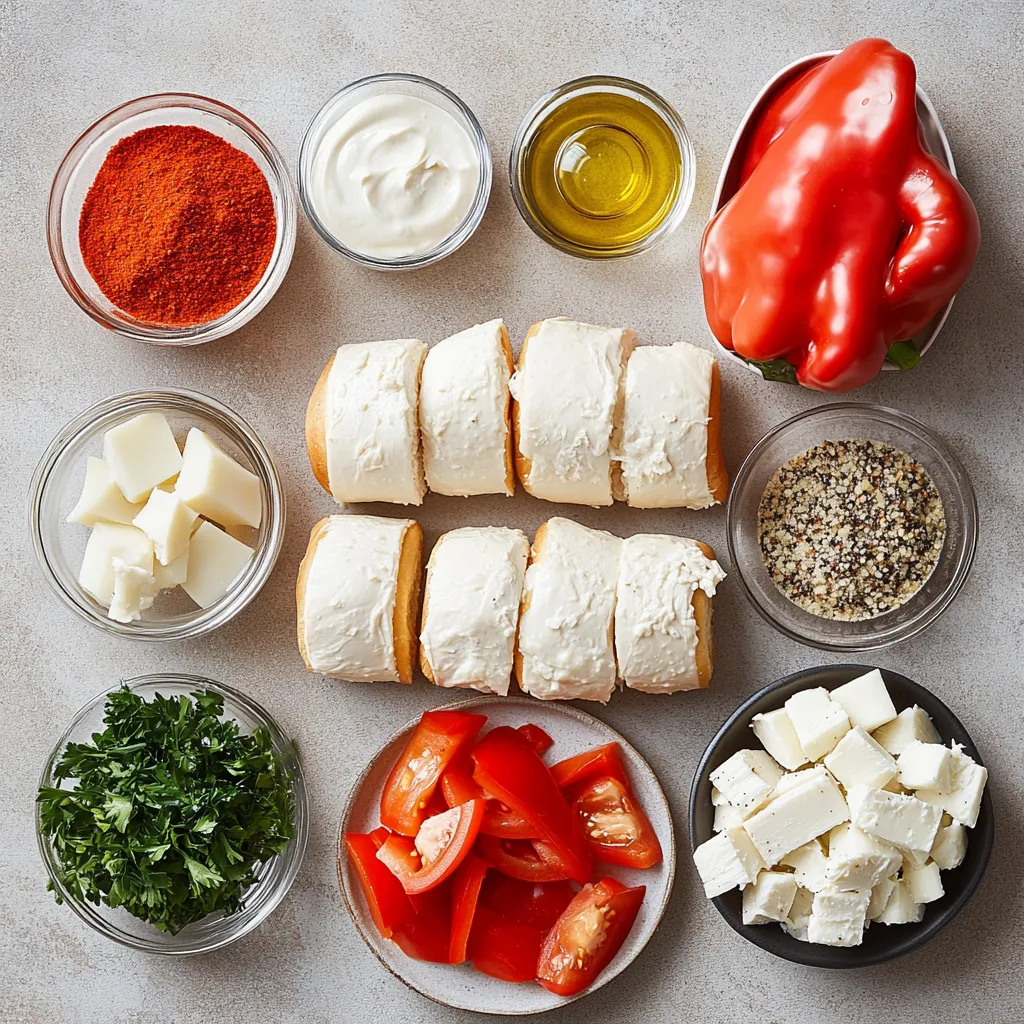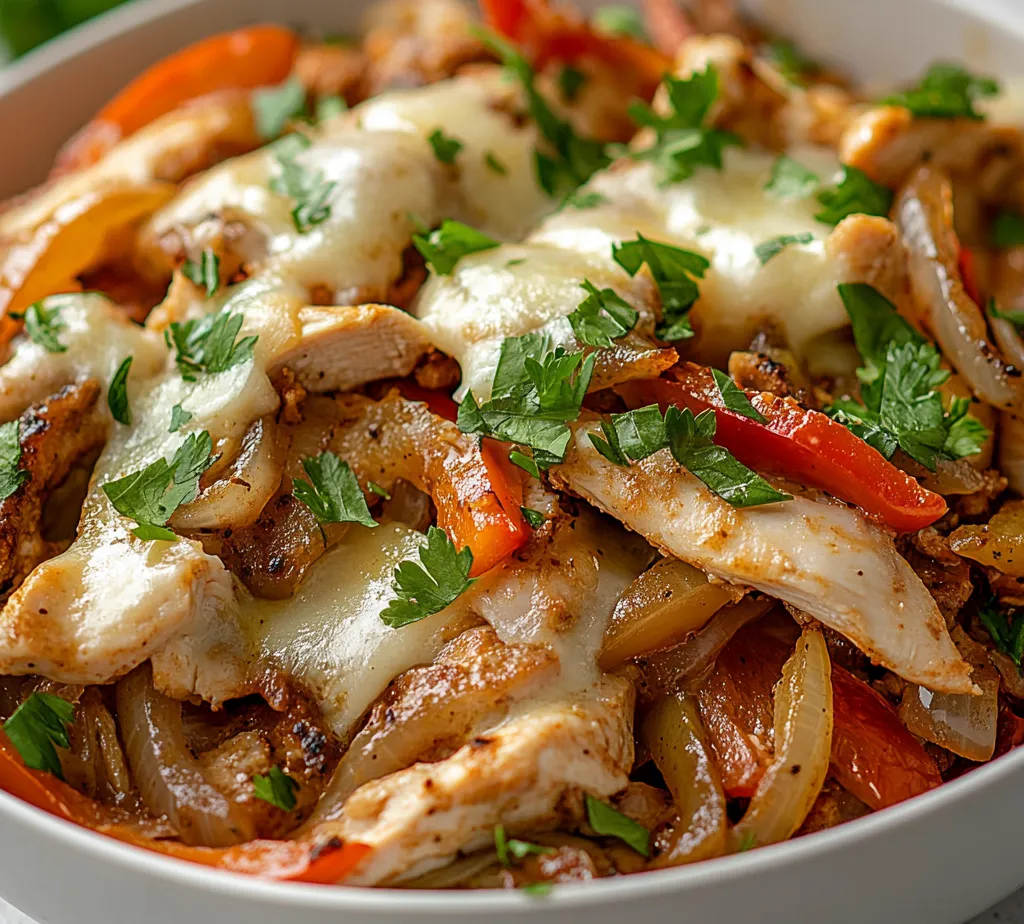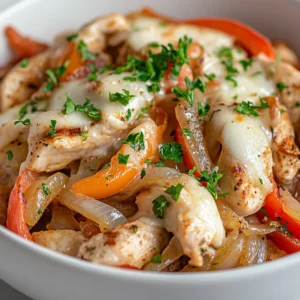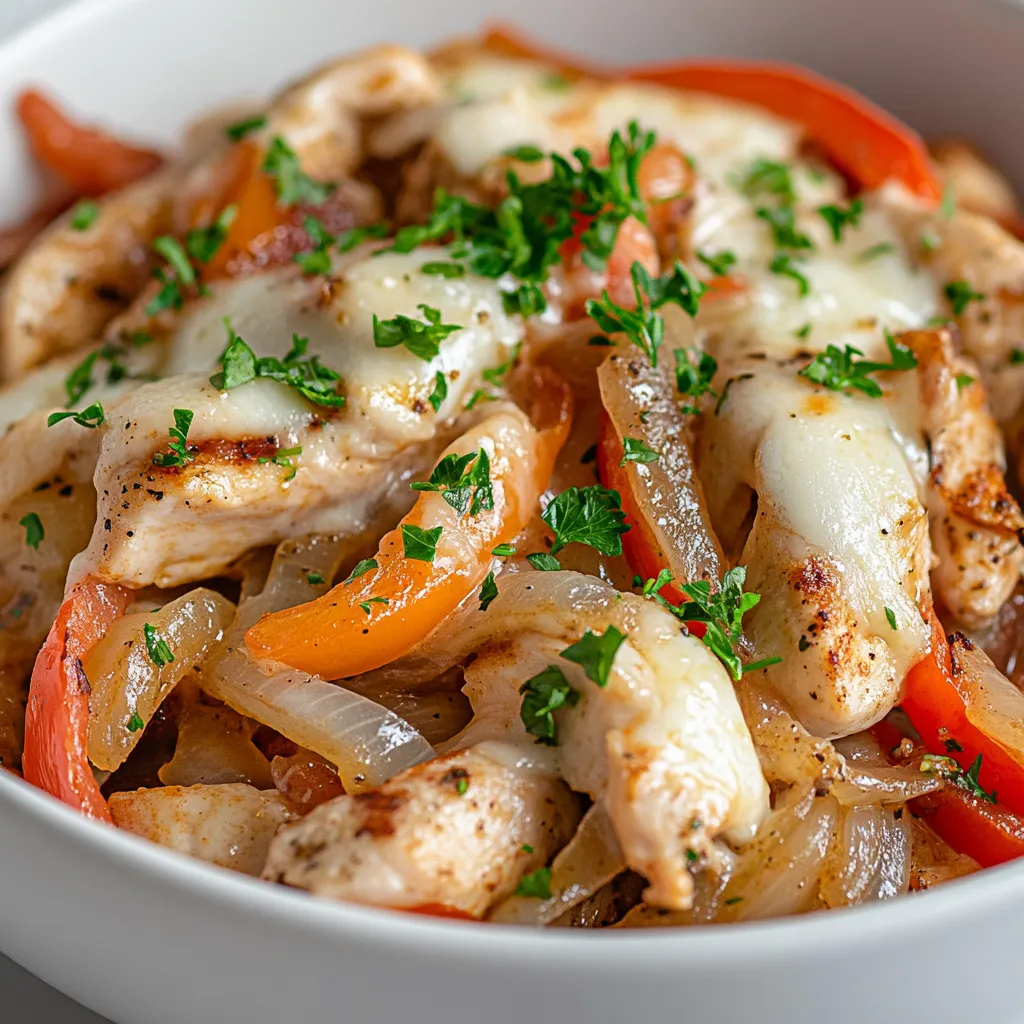Introduction
Exploring the fusion of flavors in savory chicken cheesesteaks reveals a hearty and satisfying dish that tantalizes the taste buds. This savory chicken cheesesteak skillet combines tender chicken, colorful vegetables, and gooey cheese in a simple yet delectable one-pan meal. Ideal for busy weeknights or relaxed gatherings, this dish promises comfort and flavor. The combination of mouthwatering seasonings and fresh vegetables makes it not only delicious but also visually appealing, creating a perfect atmosphere for family dinners or casual get-togethers.
What elevates this dish is the way the different textures and flavors meld together. The juicy, seasoned chicken pairs beautifully with the sweet sautéed onions and bell peppers, creating a balance that everyone will enjoy. Topped off with melty provolone and mozzarella cheese, each bite of this dish is a delightful experience. Serve it in hoagie rolls for a classic twist, or as is for a low-carb alternative.
Recipe Overview
– Total Time: 25 minutes
– Servings: 4
– Difficulty: Not specified in the recipe
Ingredients
– 1 pound boneless, skinless chicken breasts, thinly sliced
– 2 tablespoons olive oil
– 1 medium onion, thinly sliced
– 1 bell pepper (your choice of red or green), thinly sliced
– 2 cloves garlic, minced
– 1 teaspoon salt
– 1 teaspoon black pepper
– 1 teaspoon smoked paprika
– 1/2 teaspoon Italian seasoning
– 4 ounces provolone cheese, either sliced or shredded
– 4 ounces mozzarella cheese, shredded
– Fresh parsley, chopped (for garnish)
– 4 hoagie rolls (optional for serving)

Instructions
1. Cook the Chicken: In a large skillet, heat 1 tablespoon of olive oil over medium-high heat. Add the thinly sliced chicken to the skillet, seasoning it with salt, black pepper, smoked paprika, and Italian seasoning. Cook for approximately 5-7 minutes, stirring occasionally, until the chicken is thoroughly cooked and has a nice golden color. Once done, remove the chicken from the skillet and set it aside on a plate.
2. Sauté the Vegetables: Using the same skillet, add the remaining tablespoon of olive oil. Toss in the sliced onion and bell pepper. Sauté these for about 5-6 minutes, allowing them to soften and develop a slight caramelization. Next, stir in the minced garlic and continue cooking for an additional 1-2 minutes until the garlic is fragrant.
3. Combine Chicken and Vegetables: Return the cooked chicken back to the skillet with the sautéed onion and bell pepper. Stir everything together, ensuring the ingredients are well combined, and let it heat for another 2-3 minutes.
4. Melt the Cheese: Lower the heat to a gentle simmer and layer the provolone and mozzarella cheeses over the chicken and vegetable mixture. Cover the skillet with a lid and allow it to cook for about 3-4 minutes, or until the cheese is thoroughly melted and bubbling.
5. Serve: Once the cheese has melted to your liking, remove the skillet from the heat. Sprinkle fresh chopped parsley on top for a burst of color and flavor. If you prefer, serve the chicken cheesesteak mixture inside hoagie rolls, or simply enjoy it straight from the skillet for a hearty meal.
Cooking Equipment
Essential Cookware
When embarking on the culinary journey of making this savory chicken cheesesteak skillet, having the right cookware is essential for a smooth cooking experience. A large skillet is crucial for accommodating all the ingredients while ensuring even cooking. Opt for a high-quality, non-stick skillet for effortless cleanup and to prevent the chicken from sticking during the cooking process.
Kitchen Tools
In addition to your skillet, you will need certain kitchen tools to prepare your ingredients. A sharp knife and a cutting board are necessary for slicing the chicken, onion, and bell pepper with precision. Measuring spoons may also be handy to ensure accurate spice quantities, particularly when seasonings could significantly affect the final flavor profile.
Chicken Preparation
Selecting Chicken Breasts
Using boneless and skinless chicken breasts ensures that the dish remains lean and tender. This choice is not only healthier but also allows for quick cooking, making it an optimal option for busy weeknights. If you desire more flavor, you could consider marinating the chicken beforehand, though the spice blend in the recipe provides ample seasoning.
Slicing Techniques
Thinly slicing the chicken will not only help in even cooking but also contributes to an enhanced absorption of spices, leading to a more flavorful end product. A good tip is to slightly freeze the chicken for about 30 minutes before slicing; this makes it easier to achieve thin, uniform slices.
Seasoning Chicken
The spices used in this recipe—a blend of salt, pepper, smoked paprika, and Italian seasoning—enhance the chicken’s flavor profile significantly. Smoked paprika, in particular, adds a delightful smokiness that complements the other ingredients, making for a satisfying and well-rounded taste. Consider adjusting the seasonings according to your preferences for a personalized twist.
Cooking the Chicken
Heating the Skillet
To achieve a nice sear on the chicken, it is essential to preheat the skillet with olive oil. The oil should shimmer but not smoke, indicating that it’s ready for the chicken. This step is crucial, as a good sear locks in juices and creates a flavorful crust on the chicken.
Cooking Time
The chicken should be cooked for 5-7 minutes, during which you should stir it occasionally. This ensures that every piece is cooked evenly, achieving a golden-brown exterior while remaining juicy and tender on the inside. The indicator for doneness is a firm texture and an internal temperature of 165°F.
Resting the Chicken
Allowing the chicken to rest for a brief moment before mixing it with the vegetables helps retain its moisture. When meat rests, the juices have time to redistribute, leading to a juicier and more flavorful dish. This step, although brief, can make a notable difference in the texture of the final product.
Vegetable Sauté
Choosing Vegetables
Not only do onions and bell peppers add a vibrant color to the dish, but they also bring essential flavors and textures. The sweetness of sautéed onion complements the savory chicken, while the bell pepper adds a crisp bite. You can customize your vegetable selection to include other favorites such as mushrooms or even jalapeños for a spicy kick.

Opt for vibrant bell peppers and onions to add color and sweetness to the dish. The contrast of green or red bell peppers against the golden chicken and caramelized onions not only enhances the visual appeal but also contributes significantly to the overall flavor profile. Choosing sweet varieties allows for a delightful balance when paired with the savory elements of the dish.
Sautéing Process
Cooking the vegetables in the same skillet ensures a harmony of flavors, as the onions and bell peppers can absorb the delicious juices and seasoning from the chicken. This technique minimizes dishwashing and maximizes the infusion of flavor, creating a cohesive dish. The residual heat from the skillet allows the vegetables to cook without steaming, ensuring they retain their slight crunch while softening just enough to provide that satisfying texture.
Adding Garlic
Incorporating minced garlic towards the end of the sautéing process awakens the dish with rich aroma and flavor. Cooking garlic for too long can lead to bitterness, so timing is critical. Adding it when the onions and bell peppers are nearly cooked allows the garlic to release its flavor while preventing it from burning, adding a fragrant layer to the dish.
Combining Ingredients
Mixing Chicken and Vegetables
Reintroducing the cooked chicken back into the skillet with the sautéed vegetables is a crucial step in this recipe. This allows all the seasoned ingredients to mingle, ensuring an even distribution of flavors. The chicken, now golden and flavorful, enhances the taste of the sweet onions and bell peppers.
Cooking Together
Allowing the chicken and vegetables to cook together for a few minutes enhances the overall flavor and helps meld the distinct tastes. This brief time together offers a chance for all ingredients to absorb each other’s essence, resulting in a comprehensive savory profile in each bite.
Achieving the Perfect Texture
Ensure that the ingredients heat through together without overcooking. The goal is to heat the mixture until the chicken is warm again and the vegetables are at their best texture—tender but still slightly crunchy. Overcooking can lead to mushy vegetables and dry chicken, so monitoring the timing during this phase is vital.
Melting the Cheese
Choosing Cheese Varieties
The combination of provolone and mozzarella creates a rich and creamy texture. Provolone offers a slightly tangy, sharp flavor that complements the mild creaminess of mozzarella. This blend not only enhances taste but also contributes to a gooey texture that is characteristic of cheesesteaks.
Layering Cheese
Evenly layering the cheese over the chicken and vegetables ensures uniform melting, which is critical for achieving that perfect stretch and melt. The placement of cheese over the entire surface maximizes its gooiness and improves the overall mouthfeel of the dish.
Covering the Skillet
Covering the skillet assists in melting the cheese evenly and quickly. This technique traps heat and steam, allowing the cheese to soften and stretch beautifully while the dish continues to heat through. It is essential to maintain a low, gentle heat to prevent the cheese from burning or becoming overly crispy.
Serving Suggestions
Presentation Techniques
Presenting the dish in hoagie rolls adds a delightful touch to the meal. The soft bread not only serves as an edible vessel but also offers a contrast in texture against the savory filling. For a more casual serving, placing the mixture directly in bowls can showcase the vibrant colors of the dish.
Garnishing
Sprinkling fresh parsley on top enhances the visual appeal and adds a fresh note that cuts through the richness of the cheese. Consider also adding a drizzle of hot sauce or a squeeze of lemon for those who prefer a more zesty finish.
Accompanying Sides
Consider serving with pickles or a fresh salad for a balanced meal experience. The crunch of pickles adds an acidity that can anchor the richness of the dish, while a side salad introduces a refreshing component that complements the warm, savory flavors of the chicken cheesesteak.
Storing Leftovers
Cooling Process
Allow the chicken cheesesteak mixture to cool before transferring it to an airtight container. This step is essential, as placing hot food directly into the refrigerator can lead to condensation that might compromise texture and flavor.
Refrigeration Tips
Store leftovers in the refrigerator, where they will remain fresh for up to three days. Ensure that the container is well-sealed to prevent moisture loss or the absorption of other odors from the fridge, which can alter the taste.
Reheating
Reheat the dish in a skillet over low heat for optimal texture, allowing the cheese to become gooey and the chicken to regain its flavorful moistness. Alternatively, if you are short on time, the microwave can be a convenient option; just be cautious in heating to avoid toughening the chicken or overcooking the cheese.
Nutritional Information
Breakdown of Ingredients
While specific nutritional values are not provided in the recipe, an overview typically includes calories from the chicken and cheese, combined with carbs from the hoagie rolls (if used). By analyzing the quantities, one could estimate a healthy balance of proteins, fats, and carbohydrates.
Healthy Modifications
For those looking for lighter adaptations, substituting hoagie rolls with lettuce wraps offers a lower-carb alternative that still delivers on texture and flavor. Other optional variations may involve using leaner cuts of chicken or reducing cheese portions.
Dietary Considerations
Mention options for gluten-free ingredients, such as gluten-free hoagie rolls or alternatives for those with dietary restrictions regarding bread. Additionally, dairy-free cheese alternatives can be considered for lactose-intolerant individuals, making the dish accessible to a wider audience.
Conclusion
The savory chicken cheesesteak skillet is a delightful medley of tender chicken, vibrant vegetables, and melted cheese that creates a satisfying meal in only 25 minutes. The combination of flavors, textures, and colors makes it an appealing dish for any occasion. Whether served in a hoagie roll or enjoyed straight from the skillet, it’s sure to become a favorite.

Savory Chicken Cheesesteak Skillet Bliss
Ingredients
- 1 pound boneless skinless chicken breasts, thinly sliced
- 2 tablespoons olive oil
- 1 medium onion thinly sliced
- 1 bell pepper thinly sliced
- 2 cloves garlic minced
- 1 teaspoon salt
- 1 teaspoon black pepper
- 1 teaspoon smoked paprika
- ½ teaspoon Italian seasoning
- 4 ounces provolone cheese either sliced or shredded
- 4 ounces mozzarella cheese shredded
- Fresh parsley chopped (for garnish)
- 4 hoagie rolls optional for serving
Instructions
- Heat 1 tablespoon of olive oil in a large skillet over medium-high heat.
- Add the sliced chicken, seasoning with salt, black pepper, smoked paprika, and Italian seasoning. Cook for 5-7 minutes until golden and cooked through.
- Remove the chicken from the skillet and set aside.
- Add the remaining tablespoon of olive oil to the skillet, then sauté the sliced onion and bell pepper for 5-6 minutes until softened.
- Stir in the minced garlic and cook for an additional 1-2 minutes until fragrant.
- Return the cooked chicken to the skillet and mix with the vegetables, heating for another 2-3 minutes.
- Lower the heat and layer provolone and mozzarella cheeses over the mixture. Cover and cook for 3-4 minutes until melted.
- Remove from heat and garnish with fresh parsley.
- Serve in hoagie rolls or enjoy directly from the skillet.

